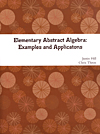- About MAA
- Membership
- MAA Publications
- Periodicals
- Blogs
- MAA Book Series
- MAA Press (an imprint of the AMS)
- MAA Notes
- MAA Reviews
- Mathematical Communication
- Information for Libraries
- Author Resources
- Advertise with MAA
- Meetings
- Competitions
- Programs
- Communities
- MAA Sections
- SIGMAA
- MAA Connect
- Students
- MAA Awards
- Awards Booklets
- Writing Awards
- Teaching Awards
- Service Awards
- Research Awards
- Lecture Awards
- Putnam Competition Individual and Team Winners
- D. E. Shaw Group AMC 8 Awards & Certificates
- Maryam Mirzakhani AMC 10 A Awards & Certificates
- Two Sigma AMC 10 B Awards & Certificates
- Jane Street AMC 12 A Awards & Certificates
- Akamai AMC 12 B Awards & Certificates
- High School Teachers
- News
You are here
Elementary Abstract Algebra: Examples and Applications

Publisher:
Lulu
Publication Date:
2016
Number of Pages:
484
Format:
Paperback
Price:
38.50
ISBN:
9781312856356
Category:
Textbook
[Reviewed by , on ]
Meghan De Witt
07/5/2016
Hill and Thron have put together a group theory book specifically geared towards mathematics education students, understanding that examples are often better than theory for students who will need to be able to explain mathematics to a younger audience. While the book has an admirable goal, it appears to have been course notes for a specific class — there are even references to what may appear on the test — that have been extended for publication without going through a sufficient editing process. There are several errors — both mathematical and grammatical. The choice of what applications to include is unusual. It is also obvious that the book was compiled from various authors, as some chapters (notably Chapter 14 on Algebraic Coding) are written in a completely different voice and pitched to a very different level of student.
The book is organized with numerous examples and the exercises are interspersed throughout the body of the text. Many of the proofs are left as exercises — some guided and some not.
The book covers only the group theory from a standard undergraduate abstract algebra course, with a mention of polynomial rings — though the definition given here of the latter differs from the standard one. A student should have an exceptional understanding of groups after reading the text.
The technical definition of a group is not given until the middle of the fourth chapter and then promptly ignored for several more. The first chapters give general background knowledge (of a college algebra level) and cover complex and modular arithmetic. This is followed by more examples — including cryptography, symmetries and permutations — as well as general introductions to set theory, functions, and equivalence relations.
Chapter 11 begins the technical examination of groups — covering the traditional topics of subgroups, cyclic groups, cosets, factor groups, and group actions. There is then a sharp detour into algebraic coding theory (the previously mentioned Chapter 14) that seems out of place in the book as a whole and in its chosen location within the text. Then we return to cover isomorphisms and homomorphisms. The books ends with an examination of sigma notation followed by an introduction to (their version of) polynomial rings. Appendices include a marvelous introduction to proofs by induction (an excellent resource for this topic in general) and a series of hints for the exercises.
Generally, the writing style is clear and conversational, though perhaps a tad verbose. The authors provide extensive background and examples. So much so that a mathematics student who might already have been exposed to some of the concepts — such as the rules of exponents, complex numbers, and the rules of arithmetic of both real numbers and polynomials — will find parts of it tedious to read. Very little mathematical background is assumed, so that the book could be used as the text for the first proof-heavy class a mathematics student will take. Linear algebra is required for Chapter 14, but other than this chapter all concepts are explained sufficiently in the book itself.
This book is clearly intended for mathematics students who need more an understanding of what groups are than the ability to work with them on a theoretical level, as more proofs are done on an example level than a theoretical one. It would not be an appropriate stand-alone text for a traditional undergraduate abstract algebra class (especially as only group theory is covered), but would serve well as a supplementary text. Schools that offer an abstract algebra course specifically for the mathematics education majors might find it suitable as a text.
Editor's Note: This review is based on the printed version of this open-source book, whose home page is http://abstractalgebra.altervista.org/. There is also an online version.
Meghan De Witt(mdewitt@stac.edu) is a professor at St. Thomas Aquinas College whose primary interests are group theory, number theory, and mathematical outreach programs.
See the table of contents in pdf format. Alternatively, visit the online version of this book.
- Log in to post comments




